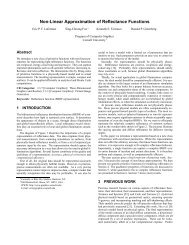pigmented colorants: dependence on media and time - Cornell ...
pigmented colorants: dependence on media and time - Cornell ...
pigmented colorants: dependence on media and time - Cornell ...
Create successful ePaper yourself
Turn your PDF publications into a flip-book with our unique Google optimized e-Paper software.
2.3.4 Waxes<br />
Historically, the most important wax for artistic purposes is beeswax. Chemically,<br />
beeswax c<strong>on</strong>tains some free fatty acids, hydrocarb<strong>on</strong>s, <strong>and</strong> esters formed from<br />
alcohols <strong>and</strong> fatty acids. Similar to drying oils, beeswax can be dissolved in natural<br />
solvents. Encaustic, or the method of painting with wax, originates from ancient<br />
Greece.<br />
Heat is used to liquefy the <strong>media</strong>, <strong>and</strong> the paint is applied hot with a brush<br />
or palette knife (encaustic literally means “burned in”). Hence, the wax does not<br />
dry, yet c<strong>on</strong>geals as it cools. In modern usage, the beeswax is often combined with<br />
resin or turpentine to increase the fluidity of the paint. A wide range of textures<br />
is possible by varying the c<strong>on</strong>sistency of the paint. Applying external heat to the<br />
artwork makes some additi<strong>on</strong>al effects. An artist may heat behind the support<br />
to keep the surface warm while brush marks are made or apply heat to the paint<br />
surface to burn in (fuse <strong>and</strong> adhere) existing layers. Encaustic paintings have a<br />
unique lustrous, rich, <strong>and</strong> translucent surface.<br />
Due to the cumbersome nature of its equipment, it was displaced by other <strong>media</strong><br />
(tempera <strong>and</strong> oil) in the Medieval <strong>and</strong> Renaissance periods. However, encaustic<br />
has seen resurgence in modern <strong>time</strong>s due to the abundance of tools to manipulate<br />
the <strong>media</strong>, including hot plates, electric tools <strong>and</strong> heat lamps. Also, since wax<br />
readily dissolves in turpentine, it is some<strong>time</strong>s used as an additive in oil paint for<br />
its textural <strong>and</strong> optical properties.<br />
2.3.5 Synthetic Polymers<br />
Rivaling oil in its versatility is a modern paint formulated from a synthetic poly-<br />
mer referred to as acrylic polymer emulsi<strong>on</strong>, or comm<strong>on</strong>ly known as simply acrylic.<br />
43



